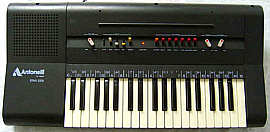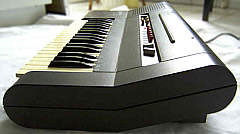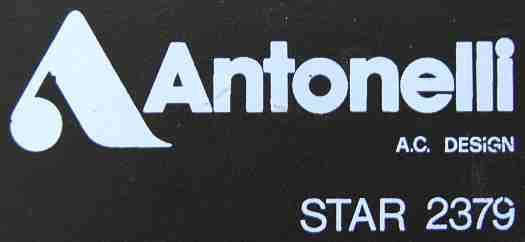 |
 |
 (full polyphonic organ keyboard with unusual accompaniment)
(full polyphonic organ keyboard with unusual accompaniment)
This bulky plastic monstrosity seems to be one of the first beginners keyboards with automatic accompaniment. It has full polyphonic envelopeless tooting squarewave organ tones, those can be muffled by 4 combinable sound preset switches. The analogue percussion consists of only 3 noises and sounds like played on only a snare drum, but interesting is the unusual full polyphonic fingered chord accompaniment, which responds so rapidly that it even accepts trilled notes and not only plays non- chords but even weird grunting cluster patterns.
 |
 |
(Note: This keyboard sounds nice, but don't buy one of these so far your only intention is to get a keyboard with faithfully imitated natural instrument sounds. Remember, this is an envelopeless squarewave organ with only simple tooting tones those sound not even remotely like what is written on its switches, though bought with wrong expectation it may disappoint you.)
The main voice sounds are simple tooting squarewave tones without any envelope. The OBS preset sound switches simply send them through primitive capacitor filters to muffle them differently. ("flute" is dullest, "reed" is medium, "string" is harshest.) They can be also combined; combinations of presets tend to be duller than the individual presets. With the "brill." switch the resulting sound can be made brighter. The vibrato switch adds a rather slow vibrato to all tones; apparently it modulates the CPU clock oscillator.
The rhythms consist only of white noise and an unspectacular dull base drum. The snare drum sounds quite realistic and impulsive, but basically the entire rhythms sound like played on only a single snare drum with different drum sticks. Instead of a "start/ stop" button the rhythm is started by pressing any of these switches. Despite the locking switches and the age of this instrument the 6 preset rhythms can not be combined to form additional rhythms. Instead the rightmost set switch overrides all others.
With rhythm off, the "accomp." switch activates the fingered chord mode, which plays full polyphonic bassy organ tones on the leftmost 12 keys (basically a key split with less than 1 octave to the left). During rhythm, the "accomp." switch instead starts an archaic automatic accompaniment those patterns consist of a 2 note bass line (playing the leftmost and rightmost of the currently held accompaniment keys) and a polyphonic piano chord (with the notes of all held accompaniment keys). Both employ a capacitor envelope for decay. Great is that the accompaniment itself does not hold any notes, thus it responds so rapidly that it even accepts trilled notes, and instead of a chord you can play even any weird disharmonic note clusters those get also gated by the accompaniment into a wildly grunting sound.
More advanced variants of this instrument were the Antonelli Star
2380 (additional features: preset sounds "brass" and "wha- wha", sustain,
chord memory, single finger chord ("O.F.C."), minor & 7th pushbutton)
and the Antonelli Superstar 2440 (44 fullsize keys, preset sounds
were named "organ" I..III and "brilliance" (possibly same like with Star
2379), single finger chord, chord memory, minor & 7th pushbutton,
8 semi- OBS preset rhythms {tango, boogie, disco, samba | waltz, march,
slow, bossa}, separate bass + chord volume knob). The top of the line model
of these keyboards was the Antonelli Syntorgan 2445 (like Superstar
2440, but no "brilliance" preset and additional a simple monophonic
synthesizer voice with 2 octave settings and switches (likely on/off, looking
like with Star 2379) for "attack decay", "attack release", "L.F.O.",
"hold VCF", "hold VAC/ VCF", "low pass", "band pass", "loud- soft" and
a "cut off" knob - the synth voice apparently could be layered with the
polyphonic organ voice (or modulated the polyphonic organ sound as well?)).
(Info found in Antonelli advertisement prospect from 1984.) Other
oversized Antonelli beginners organ keyboards of the same era (slightly
older?) were the 49 fullsize key instruments Concerto (model 2492-2493),
Concerto
II & Concerto III (Concerto III has most switches,
but still only 6 rhythms and no arpeggio; apparently only Concerto II
had piano envelopes). I am not sure if these were still full polyphonic,
but these huge rectangular monstrosities had also only few sounds and were
even much bulkier than the Star 2379. A more modern and versatile
instrument (with MIDI) which permits the same great clusters and trilled
notes in the accompaniment is the Antonelli
2495. If you want to see how small a full polyphonic keyboard can
be, take a look of the wonderful Ramasio
892; it even has more features than the Star 2379.
| removal of these screws voids warranty... | ||
 |
||
|
|